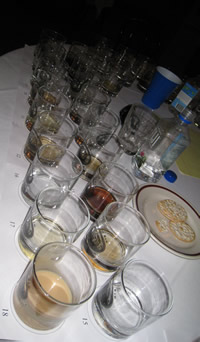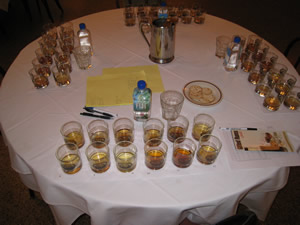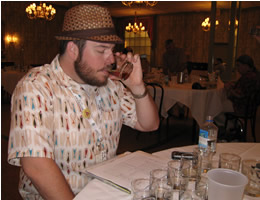Tales of the Cocktail may have officially started on July 16, but for several intrepid rum-lovers, the festivities got going on a little earlier. On Tuesday, July 15, Ed Hamilton opened the 2008 Ministry of Rum Tasting Competition. This year’s competition saw 24 judges sitting on a panel to judge more than 60 different rums and cachacas. Ed had separated the different spirits into their core groups: whites, golds, aged, flavored/spiced, cachacas, and this year saw only 1 rhum agricole and 1 overproof rum (the suspense for who will win the Gold for those categories will not be killing anyone).
On Tuesday, July 15, Ed Hamilton opened the 2008 Ministry of Rum Tasting Competition. This year’s competition saw 24 judges sitting on a panel to judge more than 60 different rums and cachacas. Ed had separated the different spirits into their core groups: whites, golds, aged, flavored/spiced, cachacas, and this year saw only 1 rhum agricole and 1 overproof rum (the suspense for who will win the Gold for those categories will not be killing anyone).
The judges were an accomplished group of rum experts from around the U.S., ranging from famous authors to respected bar owners to sommeliers to fantastic bloggers and other who have been reviewing rums and other spirits for years…and some guy that must have compromising photos of Ed or something. It was an impressive group with whom to be seated.
Ed got everyone seated in a room at Arnaud’s, and laid out the ground-rules for the tasting. The rules were fairly simple. Nose and taste the rums, write down a score in 4 different categories (aroma, initial taste, body, and finish), and add up the total. Our sheets had spaces for any comments we wanted to make, and we were given another space to specify whether or not we felt the rum was deserving of a gold, silver, or bronze medal. Each scoring category was rated from 0 – 25, adding up to a possible 100 if we found a perfect rum. The only additional rule that Ed supplied was: please do not talk to each other while judging. This was to hopefully prevent the power of suggestion from affecting the final outcome.
We began the day with the flavored/spiced rums, 19 of them in-all. Glasses were laid out on sheets of paper with 1/4 to 1/2 ounce in them, with a number next to each glass. The judges all began the process of nosing and tasting the spirits, which had already filled the room with a fruity perfume due to a problem with the cork covers that Ed had brought to preserve the nose. These being the flavored rums, there was plenty of nose left. This being my first experience sitting as a tasting judge, I was a tad nervous. The intense, silent focus in the room was reminiscent of taking an important test in school. Martin Cate, from Forbidden Island, had warned me about this the night before, saying, “You’ll feel like you’re taking your SAT’s or something.” The only sounds in the room were those of sniffing and the occasional glass clinking.
This being my first experience sitting as a tasting judge, I was a tad nervous. The intense, silent focus in the room was reminiscent of taking an important test in school. Martin Cate, from Forbidden Island, had warned me about this the night before, saying, “You’ll feel like you’re taking your SAT’s or something.” The only sounds in the room were those of sniffing and the occasional glass clinking.
Every judge seemed to have their own approach to working through the samples. Some nosed all of the glasses first and then rated the noses for the entire group before moving on to the palate, while others worked through a single rum at a time. Most (but not all) judges made use of a spit-cup to prevent intoxication, which could be a real concern with so much spirit on the tables. Between tasting the various samples, judges would cleanse their palates with bottled water and neutral crackers.
After roughly 90 minutes, the judges had all turned in their scoring sheets, and Ed revealed which rums were which numbers. The judges gathered closely around the bar, taking pictures and taking notes on which rums matched their tasting notes and scores. There was a great deal of conversation about the difficulty in judging flavored rums because most of the classical rum characteristics that one looks for are covered with the flavors and spices. Personally I tried to determine what the producer was trying to accomplish (e.g. is this peach or mango?), and then judged by how well I thought their offering demonstrated that desire, or if I could even pinpoint their goal at all. Following a quick lunch, the judges all filed back in to the room and took their seats in front of a collection of 12 aged and premium rums (followed by a separate rating with a single rhum agricole), and the process was played out in a similar fashion. The rums ranged from well-known and common in the US to rums that are currently not on the market. There were a few surprised looks at the reveal. Blind tasting is very different from what I typically do, and many judges were discussing that in a blind tasting you’ll often find that you score your usual favorite rums as the worst and your least favorite rums as the best. Some of that has to do with how your palate changes from hour to hour based on things like what you’ve eaten or how you feel, and some of it is just the universe making fun of you.
Following a quick lunch, the judges all filed back in to the room and took their seats in front of a collection of 12 aged and premium rums (followed by a separate rating with a single rhum agricole), and the process was played out in a similar fashion. The rums ranged from well-known and common in the US to rums that are currently not on the market. There were a few surprised looks at the reveal. Blind tasting is very different from what I typically do, and many judges were discussing that in a blind tasting you’ll often find that you score your usual favorite rums as the worst and your least favorite rums as the best. Some of that has to do with how your palate changes from hour to hour based on things like what you’ve eaten or how you feel, and some of it is just the universe making fun of you.
This entire process was played out twice more on Wednesday. In the morning a selection of 18 gold rums was placed in front of the noses and palates of the judges. The reveal followed, and in the afternoon a segmented session first of 7 white/silver/platinum rums, followed by 4 cachacas, and then a single overproof. After 2 days of drinking rum from 11 in the morning until 5 in the afternoon, the judges and their exhausted palates turned in their final scoring sheets and made their way back to the Hotel Monteleone. After dropping off bags and other sundry items, several judges went with Ed Hamilton to Margaritaville (of all places) for ti’ punch. Ed makes a fantastic ti’ punch, and the people behind the bar had no problem letting him work in front of the bar to make the drinks.
After 2 days of drinking rum from 11 in the morning until 5 in the afternoon, the judges and their exhausted palates turned in their final scoring sheets and made their way back to the Hotel Monteleone. After dropping off bags and other sundry items, several judges went with Ed Hamilton to Margaritaville (of all places) for ti’ punch. Ed makes a fantastic ti’ punch, and the people behind the bar had no problem letting him work in front of the bar to make the drinks.
Finally, on Saturday, July 19, The Minsitry of Rum posted the results of the 2008 Ministry of Rum Tasting Competition. Congratulations to all of the medal-winners!
For those of you interested in reading more about this year’s Tales of the Cocktail, be sure to check out the group blog: TalesBlog!

Comments on this entry are closed.
Silvio
Ahh, the long expected article. Great job Dood, this article pretty much answered all the questions I had about this tasting event. Nice hat!
Capn Jimbo
Great stuff, you really made this even come alive. But a few questions:
1. If you wanted more of a particular rum, could you get it?
2. Were any criterion laid out for each subcategory, or any further guidance given insofar as how to assign a score? EG with aroma, would an alcoholic prickle be a good thing or not? Was a short finish better than a long finish? Etc.
3. Personally, Sue Sea and I would have a very hard time judging a finish without, uh, finishing the sip. Same with aftertaste or retro-olfaction, if any. Of course I understand the spit cups, but don’t you think this (and the number of samples) is inhibiting?
4. Some very important characteristics seem missing, eg complexity, balance, development, et al. Things we all value but apparently not addressed. How were these addressed? Was the characteristics of a fine rum defined for each category?
It would seem some judges broke their judging down by the four categories (going around comparing aroma first, then taste, etc), while others completed one at a time. I would think the latter more accurate. How did you go about trying to make sense of the number of samples and the scoring system/
3. What were the pluses and minuses of the tasting scheme used? Was having to break down a rum into the four components a problem? Could you just turn in a final score?
4. How was scoring done? Were all scores put out for all to see? Were you able to view losing rums and scores? What surprises and observations can you make for the losers?
5. You mentioned that judges were also queried on whether a rum was deserving of say, a gold or silver? On what basis?
6. 5. Last how did your scoring compare? Were you picking winners? How did you feel? And what would you have changed?
Last, I can’t help but take note of the Beverage Tasting Institute method, which seems to address many of these issues. They do not break down a rum into components (aroma, etc). They break the tasting into three simple rounds with just four ratings, eg. the first round rates them from 1 to 4 :
1–Not recommended (less than 80 points).
2–Of sound commercial quality, though not overly exciting (80-84).
3–Shows style and character, yet probably not of the highest merit (85-89).
4–Highest quality.
Those earning at least two “4’s” go on to a second round which are scored from 3 to 6:
3–Very good, but not of the highest merit (88-89 points).
4–Truly excellent in style and distinction (90-92).
5–Outstanding, though not quite one of the world’s finest (93-95).
6–Provides a world-class experience (96-100).
I won’t go into further detail, but rums whose scores vary widely or very poorly are retested to make sure it wasn’t a bad sample, and to insure quality and repeatedability.
All rums scoring “4” or better are tasted twice. Scoring is done not by the judges, but by BTI, by compiling and combining the rounds to end up with scores from 80 to 100.
Their testing is based on their tenets that the shorter the scale, the easier it is for tasters to repeat their scores – and that repeatability is the essence of accuracy. They don’t want to confuse or overwhelm the tasters, and they want their scores to be meaningful and accurate.
Forgive me for my curiosity, but I’ve been to tastings where rums from a particular nation are presented consecutively in very small cups. Great fun, but not really effective. You have to get “seconds” of the ones you like.
I’d love to get your take as a front line judge fighting in the battle for rum excellence! Thanks for bearing with my obsessive curiosity. And remember…
Only you can prevent forest fires!
Jake Parrott
Re comment 3 above, I have no problem assessing a finish without spitting. The key is taking a large enough sip and aerating well in the mouth. There aren’t any taste buds in your gullet, and retro-nasal aromas come as much from volatilization off the hard palate than anywhere else.
In addition, spitting does prevent intoxication, which even at mild levels inhibits discernment and concentration. In addition, I find that tasting-and-spitting forces me to slow down, to consider, to analyze, to deconstruct, which are the important activities in capital-c criticism.
Matt Robold
Hey Jimbo,
Just a quick note to say that I am not ignoring your comment, but rather trying to fashion a full response to it. I’ve been out of the office for a week and my time has been a bit cramped since my return.
Jimi
Great review, I’d like to try El Dorado 15yr cause it’s sounds interesting (in name only as I’m a Rum Noob). My question to you is this, hands down what was your favorite and did it take home any honors?
Matt Robold
Well I’ll be replenishing my supplies of ED15 this week, so we’ll get you all sampled up next time we hang out.
As for favorites, I don’t know that I had one in particular. The ED15 took home a gold, and I was also very fond of the Temptryst Maplewood, which took home it’s own gold medal as well.